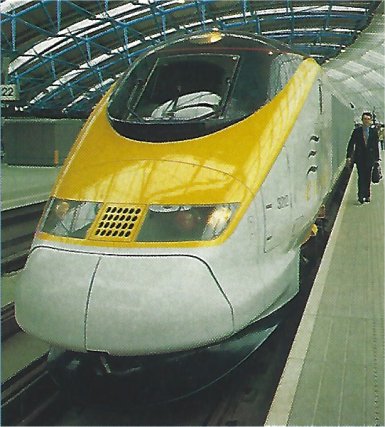| The Eurostar. |
||
| Christened the ‘Channel Super Train’, this train took to the rails in 1994. It connects London with Paris or Brussels bringing the French capital within 3 hours, compared to the 6 or 7 previously necessary since the ’20s. | ||
|
No stopping in the tunnel Repeatedly planned, begun, abandoned and begun again for more than a century, the Channel Tunnel is now traversed by Eurostar in less than 20 minutes. The train has to comply with the following conditions: |
Number of seats for the whole train 794, line. 210 first class and 584 second class. |
|
|
A train for three completely different networks. Although Eurostar is technically a descendant of the French TGV, it has been developed to be able to run on three very different systems, while most TGVs can run only in France. Eurostar travels at around 185 mph in France on a new line with a catenary supply of 25kV, 50 cycles single phase. The axle limit is 17 tonnes per axle with ‘on board’ signalling or normal SNCF signalling on ordinary lines. In Belgium, trains run on the standard network as well as a high speed dedicated line, with catenary supply of 3000 VDC and normal signalling. |
 |
|
|
In the UK, running is on a much older network (Southern Railway) drawing traction current at 675V DC from a third conductor rail with normal signalling completely different from the other two systems and under a much smaller loading gauge which limits the maximum size of the vehicles. In addition the train on different European routes has to cope with five different ‘on board’ signalling systems, four different platform heights, etc. |
||
|
Safety first and foremost. In the 'Chunnel' speeds can rise to 100mph on the normal SNCF supply voltage but with extremely severe safety rules: the train must be aide to proceed with only one third of its motive power functioning and must be capable of being split in two, allowing part of the train to evacuate the tunnel with all the passengers in case of accidental damage to the other part of the train. |
Technical Data |
|

